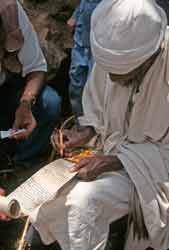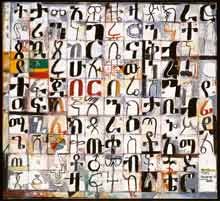 |
|
Like Tifinagh, the Ge'ez script-also known as Ethiopic-has been in continuous use for more than two millennia. It is distantly related to Sabaean, an alphabet brought to Abyssinia (ancient Ethiopia) from Arabia around the 6th century B.C. Christian Ethiopians in the 4th century A.D., intent on writing the Ge'ez language, developed the script into a distinctive syllabary, an alphabet in which each symbol represents a syllable made of a consonant and a vowel. Although Ge'ez ceased to be a commonly spoken language by the 13th century, it continues to be used as the liturgical language of the Ethiopian Orthodox Church. It was later adapted to write other Ethiopian languages, including Amharic, now the national language of contemporary Ethiopia.
The ecclesiastical arts of Ethiopia combine word and image to create aesthetically powerful objects of healing and devotion, such as illuminated manuscripts, icons and prayer scrolls. Indeed, the very act of writing Ge'ez possesses a mystical dimension for Christian Ethiopians, many of whom view the script as an evocation of the origins and mysteries of the Christian faith. Ge'ez has also inspired contemporary Ethiopian artists such as Wosene Worke Kosrof, whose inventive compositions blur the boundaries between script and image.
|

Fisseha Gebrekidane, a professional scribe, completing the inscription for a healing scroll,
Tigray Province, Ethiopia.
Photograph by Raymond Silverman and Neal Sobania,
1997.
|

Gebre Sellassie Gebru, a professional scribe and deacon in the Ethiopian Orthodox Church, inscribing a healing scroll.
Axum, Tigray Province, Ethiopia. May 27, 1997.
Photograph by Raymond Silverman and Neal Sobania.
|

Wosene Worke Kosrof
The Color of Words IX
2002
Acrylic on linen
Collection of Azzulina, Danville, CA
Wosene Worke Kosrof considers his recent works to be investigations into a new alphabet, one that employs a vocabulary of signs and symbols to link past with present, and Africa with the diaspora in which he works and lives. Drawing upon Ethiopian graphic systems, liturgical symbols and architectural forms as well as pan-African motifs, the artist produces richly colored and detailed canvases. Wosene's fascination with words and the seductive forms of written signs are contemplated alongside other investigations of language and identity within modern histories of Africa.
|


|
|

|








